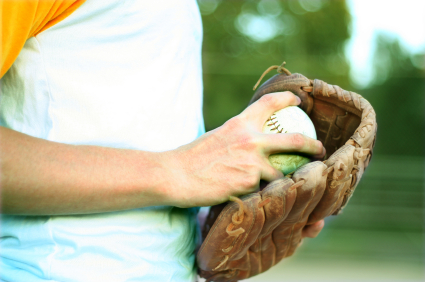This week, we finish our quest to help you improve your catch-play with a segment dedicated to pitchers. Since the most important thing that pitchers do is throw the ball, we don’t need to waste time convincing you that playing quality catch is extremely important in taking your game to the next level. Let’s get right to the 6 areas that you can work on to continue improving and get your daily catch play routine dialed in and helping your prepare for success in the games.
1. Your Delivery
This one may seem obvious and most pitchers don’t need to be reminded that catch play and flatground time is a great time to work on your delivery and dialing in your pitching process. When playing catch each day, you should devote plenty of time to working on your delivery and improving your movement patterns. This might mean anything from working to be consistent and repeatable with your mechanics to practicing different timing mechanisms that could throw the batter off (think Marcus Stroman and Johnny Cueto!). Work the wind-up and the stretch. Work on building quality habits with pitching related aspects of throwing by having a plan and working on specific things on a daily basis and not just when you are throwing your bullpen. Whether just getting loose at 30 feet, or fully warmed up at 60 feet, you can use this time to truly get to understand the way your body moves and feels throughout your delivery. Let your arm go at the speed of your body and stay synced up, work on throwing with different levels of intent, and keep your movements, mechanics, and mental focus in mind!
2. Working on Different Throws
While working on your mechanics/delivery is important during your catch routine, working on non-pitching throws is equally important. Set aside daily time to practice making throws outside of your pitching delivery. Many pitchers get too accustomed to always pitching the ball and don’t devote enough time to simple quality catch (one reason why many pitchers develop problems throwing to bases). Work on these defensive throws during your catch play. Practice fielding the ball and making a play or throwing the ball to your catch play partner as if he’s an infielder at a base. Being able to spin the ball, make throws with touch and feel, and make throws from a variety of athletic body positions and arm angles are all important and needed skills. You will have to make throws from the field as a defender, so devoting a portion of your throws each day to getting in these reps will really pay off over the long haul. If you don’t practice, bad throws may cost you bases, runs and even games. By working on these skills as part of your catch play, they will start to become second nature and thoughtless in games.
3. Picking a Specific Target = Getting Specific Feedback
Just like the flight of the ball off the bat provides hitters with a ton of feedback about what they are doing, so too does throwing the ball. This is especially the case when you pick a specific target to throw to. Don’t work on simply throw the ball to your partner, pick out a specific and small spot. If you are simply throwing the ball to your partner, hitting him in his left shoulder might not provide you any feedback because you hit your target. However, if you are throwing at a letter on the middle of his shirt and hit his left shoulder, that tells you something and gives you feedback to make an adjustment. If that seems like it’s being overly picky, think about how big a different missing your spot by 8-10 inches can be on a pitch? Hopefully that helps drive home the point that you need to aim small and specific so that you can miss small and get specific feedback to make throw-to-throw adjustments. See if you can go without making the same miss twice in a row. As hitting the same target becomes too easy, pick two different spots and alternate between the two, much like moving locations around from pitch to pitch. After all, being able to make the ball do what you want and putting it where you want is a huge key to success on the mound.
4. Alternating Different Pitches
Once you are comfortable with changing locations (and hitting your targets!), alternate throws using your fastball and change-up (or any other secondary pitch) with an emphasis on maintaining the same delivery, arm speed, and arm slot on both. You don’t have to do this at max effort. This will help you get comfortable with your secondary pitches and alternating between the two can help you discover differences in your delivery of the two pitches. Doing this from different distances 45-80 feet can also provide some helpful feedback. For example, throwing your change-up from beyond 60 feet can be really helpful in showing you if you are over-manipulating the ball or pushing the pitch. Get creative and explore what might be helpful for you. Training your body to adapt to different variations can be incredibly helpful to getting your body to sync up and making adjustments.
5. Long Toss
It goes without saying that we believe in long-toss and we believe in the importance of airing it out. This could be an entire book, but work with your coach to develop a long toss routine that you can continue to use throughout the season. For any suggestions, we suggest you check in with our friend Alan Jaeger at Jaeger Sports. We believe in their protocols and philosophy on airing it out.
6. Picks
At the end of your catch routine, take a few minutes to work on controlling the run game and your pick-off move. Position yourself to simulate throwing to 1st, 2nd, and 3rd and work on quick feet, a short arm, and accurate throws. Work on mixing your looks and holds before delivering the ball to your partner. Put yourself in game-like situations for mental practice and work at game speed so when you need to execute in the game, it’s second nature. The more you can visualize and make it feel game-like, the better. You want to train your mind for the high pressure situations with runners on, so when you get to them in the game, you already have thousands of reps to lean on. Ask your partner for feedback and make controlling the run game a daily focus!
We could probably go on forever with ways for you to improve your catch-play but now, it’s up to you to put in the work!







